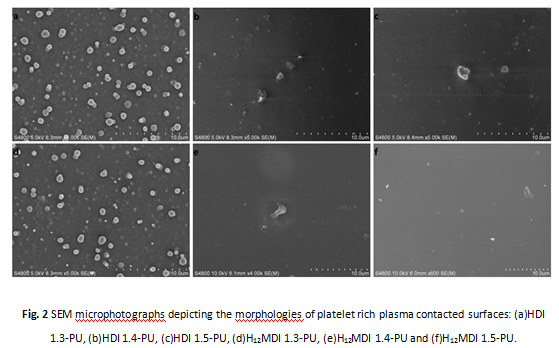Introduction: In this study, to obtain biomedical polyurethane elastomers with good mechanical properties and biocompatibily [1],a series of polycarbonate urethanes were synthesized via a two-step solution of polymerization method using the poly(1,6-hexanediol)carbonate diols (PCDL) as the soft segment, 4,4’-methylenebis(cyclohexyl isocyanate) (H12MDI), 1,6-hexamethylene diisocyanate (HDI) and 1,4-butanediol (BDO) as the hard segment with dibutyltin dilaurate as the catalyst. In this article, we illustrated the physical behaviors were obviously influenced by synthetic routes. And their chemical and physical structures were investigated by GPC,DSC,FT-IR and mechanical properties tests [2]. The surface wettability were studied by contact angle measurement (CA). A comparative analysis was made between the commercial medical polyurethane materials and the synthesized materials, showing the poly(carbonate-urethane) elastomers were better in mechanical properties [3]. Finally, the results of the hemolysis and platelet adhesive tests were recorded by spectrophotometer and SEM, indicating the materials were in accordance with the standard for biomaterials.
Materials and Methods: The polyurethane films can be easily synthesized via a two-step reaction using PCDL and diisocyanate coupled with a chain extender BDO.And all the reagents added to the reacting round-bottomed flask were dissolved in DMAc or DMF. After that, the mixture was cast into a beaker for precipitation, with ether-water solution in it. And then the polymer was placed in Soxhlet extrator using deionized water as extracing agent for removing small molecules for at least 24h. And then, after being dissolved in THF (7.5 wt%) with stirring at 800 r/min for 2 h, the polyurethane solution was placed in a vacuum oven at 45℃. Finally, in order to keep the surface of the polyurethane flat, the prepared polymer solution was put in homemade molds carefully for drying at room temperature. The tests on mechanical properties could be carried out after drying in the vacuum oven at 40 ℃ for at least 5 days.
Results and Discussion: The polycarbonate polyurethane films have been successfully synthesized and the results of CA measurement indicated H12MDI-PUs were better in hydrophobic property. As for mechanical properties showed in, the series of polyurethane films were better than Pellethane 2363-80A did, especially for H12MDI 1.5-PU.

It displayed tensile strength of less than 10 MPa and showed the best properties in elongation getting about 850% at break. The results of the hemolytic tests indicated the materials were in accordance with the standard for biomaterials and the SEM pictures of platelet adhesion experiment in showed there were little platelet adhering to the polyurethane films.

In order to get more advantages as a kind of short-term biomaterial, we’ll concentrated on doing some researches to enhance the hydrophobicity and improve the biocompatibility without reducing the mechanical properties.
Conclusion: In this article, the physical properties of our prepared polymers were even better in flexibility and elongation at break after the comparison with a commercial biomedical polyurethane. Our ongoing work have demonstrated that H12MDI 1.5-PU has great potential in biomedical field. In order to get better applications as a candidate for elastic biomedical material, some modifications are still should be made to improve their biocompatibility.
The HongKong, Macao and Taiwan Science & Technology Cooperation Program of China (No.2015DFH30180); the Key Grant Project of Chinese Ministry of Education (No.313041); the Key Technology Research Plan of Wuhan Municipality (No.2014060202010120); the Fundamental Research Funds for the Central Universities (WUT:2014-Ⅶ-028)
References:
[1] H. Sheikhy, M. Shahidzadeh , B. Ramezanzadeh, F. Noroozi, J. Ind. Eng. Chem., 2013, 19,1949-1955.
[2] T. Choi, J. Weksler, A. Padsalgikar, J. Biomater. Sci. Polym. E.,2011, 22, 973-980.
[3] D. Joyeeta, N. Kinsuk, RSC Adv. , 2014, 105, 60831-60841.